Visit Library for MBP Pro eBooks |
Last week we completed the first of my two Japan Winter Wildlife tours for 2023. The pandemic prevented us from running these tours in 2021 and 2022, so it was the first tour in three years, and it was so nice to photograph the wildlife in Hokkaido again, and visiting the Snow Monkeys in Nagano is always so much fun. I’ve selected thirty images of the 180 or so that I selected from the trip, and will share these images ten at a time, over three episodes. With just six days between tours this year, I am sitting down to prepare for this first episode just two days before I leave for the final winter tour of the season, and I’m going to try really hard to create a second before I leave, but that may not be possible with so much left to do. Let’s see how it goes.
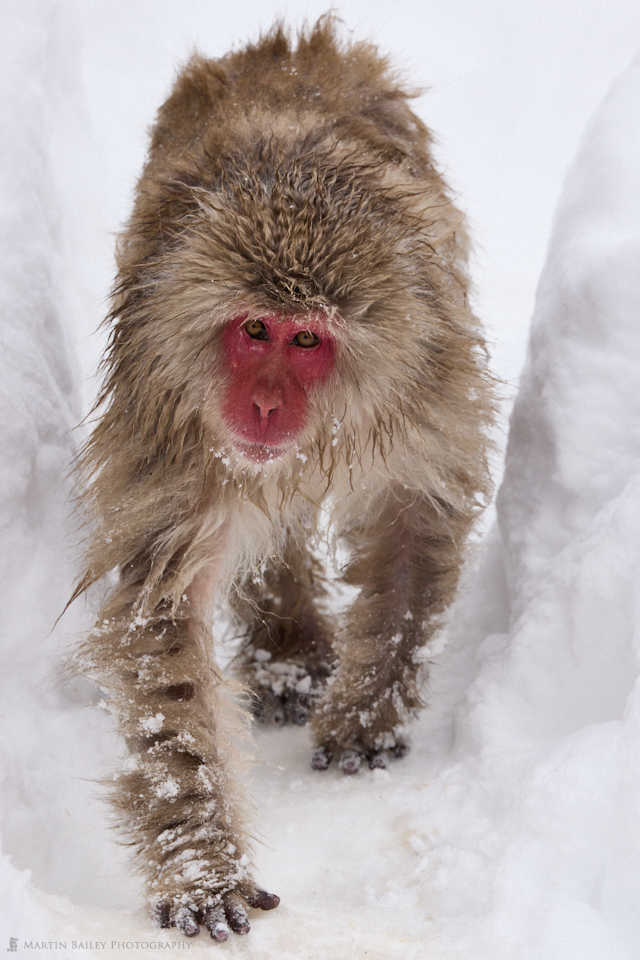
We started our trip, as usual, with three days in Nagano, a prefecture northwest of Tokyo, where the snow monkeys have become known worldwide for bathing in hot springs pool in their snowy valley. Despite having had a lot of snow along the Japan sea coast of Japan for the last few months, it turns out that there had been no snow at the snow monkeys until just a few days before we arrived, so although we didn’t get any falling snow during our time with the monkeys, there was plenty of snow in the valley, and we did have fresh snow each night to keep everything nice and clean.
The number of overseas visitors to Japan has recovered to around 50% of what it was before the pandemic. Still, the number of people visiting the snow monkey park was probably back to previous levels. I had been concerned that we had to time our visit for a weekend, but the hotel staff assured us that the day of the week didn’t matter. There were crowds at the snow monkeys regardless, and having visited on a Saturday, Sunday, and Monday on this tour, I can confirm that Monday was no different from the weekend days we visited.
So, in our usual manner, we worked around the crowds, some of which would spend just five minutes with the monkeys, get a handful of iPhone photos, then leave. That seems crazy to me, but the opposite is probably just as true. Visiting three times, for a total of two full days, probably seems just as crazy to the casual tourist.
Outside of helping my group with their photography, I spent a lot of time watching the monkeys in the snow and waiting for a percentage of them to walk through the channel they’d made to get down the hill to the pool area. This image is my favorite shot of this. With the sun not shining directly into the valley at this time of year, we do have to pump up the ISO a fair bit to get a good exposure, but that’s fine. As I teach my group, as long as you keep increasing the ISO to the point that your histogram data is as far to the right as possible, you don’t have to worry about grain until your ISO gets really high. On the R5, I’m routinely going to around 6400 without worrying about it, and I rarely have to deal with grain. I shot this image at ISO 2000, with a shutter speed of 1/1000 of a second and the aperture set to ƒ/11.
I’m happy to report that the Canon EOS R5 has turned out to be just as impressive a camera for this type of photography as it is for everything else. The high frame rate is nice to have after shooting with the sluggish 5Ds R before moving to mirrorless, and needless to say, the R5 is worlds ahead of the EOS R, which worked but has turned out to be every bit the stepping stone camera I expected it would.
The one thing that I am still not 100% sure about after the 12 days of shooting on this tour is whether or not the viewfinder is better weatherproofed than the EOS R, which fogged up and became almost entirely unusable in heavy snow. We shot in the snow to a degree, but not heavy snow on this trip, so I won’t know if that problem has gone away until I work in some heavier, harsher conditions.
In addition to watching for monkeys coming through the channel in the snow, I watched for exciting interactions, such as this display of aggression from one angry monkey and the indifference of the monkey that was the target of the aggression. With most of these photos, because I’m exposing the snow so that it doesn’t get overexposed and retains its texture, it’s generally necessary to increase the exposure of the monkeys a little, using the Shadows slider. This works in Lightroom as in Capture One Pro, my software of choice.

Occasionally, a fight between two monkeys results in one of the monkeys bursting through a bank of snow, and for many years I’ve been trying to capture that. Unfortunately, it generally happens so fast and without warning that I’ve failed to get my camera to my eye and focus in time to get the shot. I would love to get this with the monkey bursting through the snow straight toward the camera, but on this visit, I did get a monkey that was chased as it jumped through the fresh snow, although it was not coming toward me, as you can see in this next image.
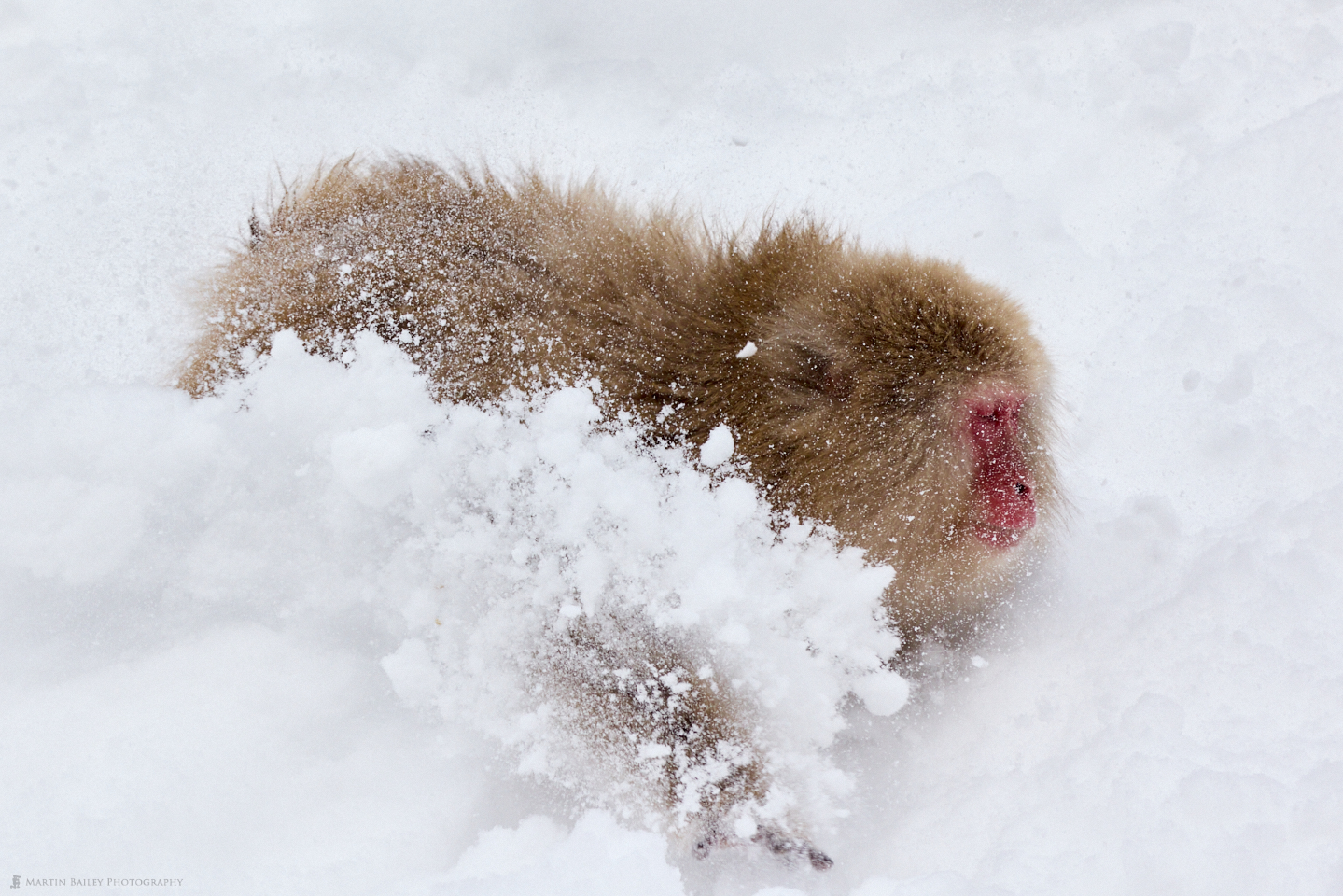
Another tip on photographing the snow monkeys is that the light is often very blue because it’s reflected light, and the snow generally makes the light blue anyway. I have always used the picker under the white balance tool in Capture One Pro and selected the white snow, which then sets a custom white balance to make the snow white, and the monkeys a lovely warm tone, as you see in my photos. Many of the guests on this trip that are using Lightroom though reported that they were getting a yellow cast when they used this method, which had me stumped during the trip. As I write this, I realize that this could have been caused by the snow being overexposed, as the white loses it’s color information when overexposed, but if you try this and see any issues in Lightroom, check the exposure of the snow with the histogram and if it’s not over, and if you also see a yellow cast, please let me know via the comments. Someone may need to let the Lightroom team know that there is a problem.
Although still not a frontal burst through the snow, I watched this monkey on top of a rock for quite some time in the hope of getting this shot, as I knew there was a good chance that the monkey would come down from the rock in this way. Unfortunately, that brown fern sticking out of the foreground snow covers most of the falling snow, so this is not as good a photo as I’d hoped, but I think it’s still got enough merit to stay in my final selection.
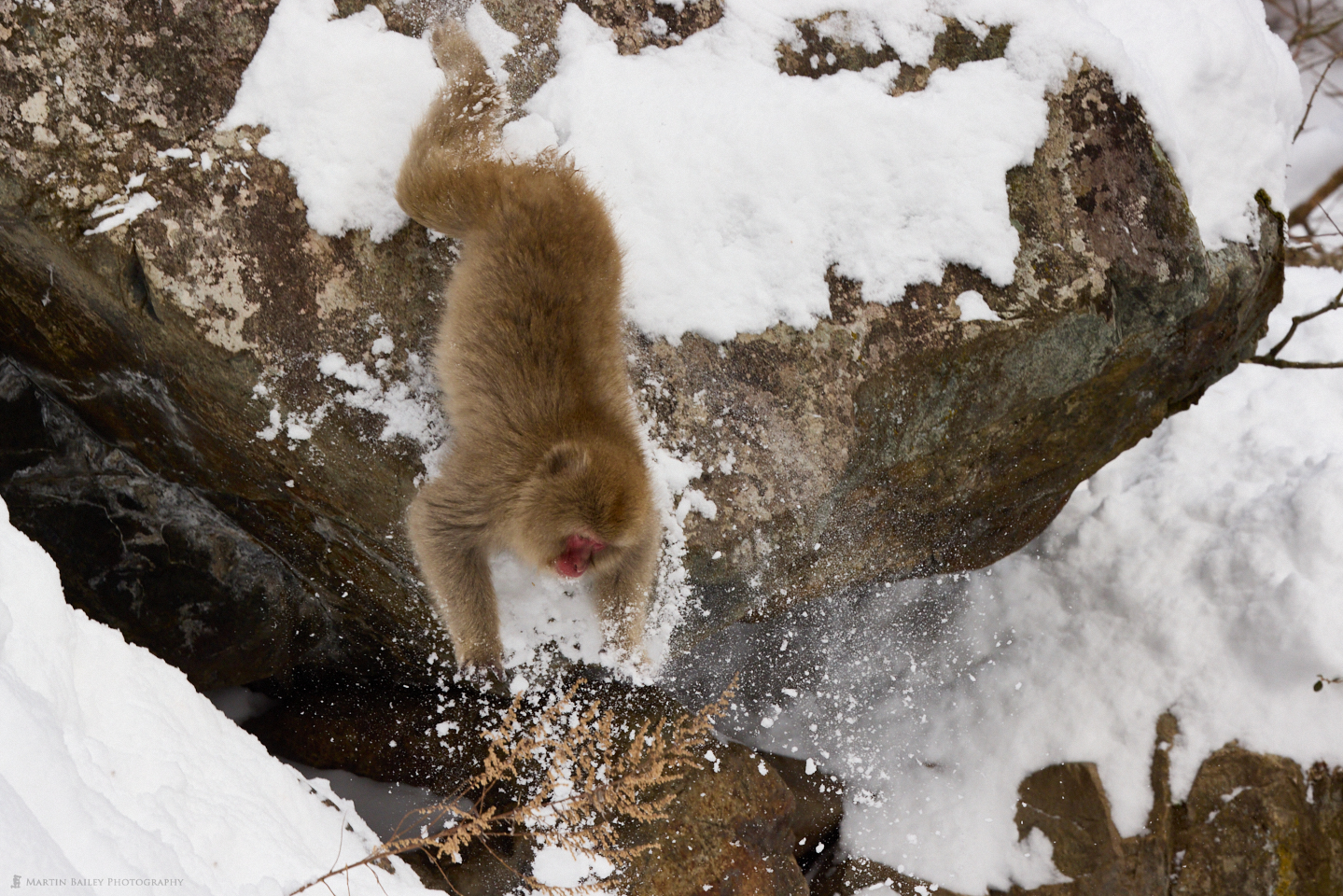
On the final morning with the monkeys, I went down to the pool for a while and got this moment when a young monkey was pulling the hair of another, stretching the skin around its eyes back, and causing it to bear its bottom teeth. I have a second where the adult grimaces at the mischievous monkey, but I prefer this shot, showing the interaction between the two youngsters more prominently.


Another type of snow monkey photo I enjoy capturing is this kind of portrait, where the monkey looks deep in thought. If I was to show you the frames before and after this, though, the cat, or maybe I should say the monkey, would be out of the bag. This little monkey isn’t really deep in thought. Its eyes were closed for less than a second, but the pose otherwise leads us to believe the story, and in many ways, it suits us to believe the more human emotion.
I have captured monkeys with their eyes just closed, and having watched them for so long, I know that there are times when they think hard about something, but without the ability to get inside their heads, it’s hard to know just how close to human thinking these guys are. Still, for the 1/1600 of a second that it took for this photo to be recorded, I’m happy to believe that this little guy really is deep in thought.
The heavy snow and nightly top-ups of fresh snow gave us many areas where the monkeys could be captured surrounded by snow. One such place was on their route back into the mountains from the pool and river, where the monkeys are fed grain to help them get through the winter and conveniently get them to come down into the park to be photographed. On cold clear days, as it was on our final morning, the monkeys come down to feed and then retreat to the mountains quite quickly because it’s warmer in the sun that only reaches the higher levels of the valley walls.
My shutter speed for this was 1/1000 of a second, and the ISO 1600 with an aperture of ƒ/10. These are pretty much my standard settings, although I sometimes go to 1/2000 of a second with a higher ISO to freeze motion if I anticipate something a little more dynamic, like the snow burst that has continued to evade me over the years.
I was able to get a number of shots of the monkeys crossing this clean patch of snow, but this image with the baby riding on its mother’s back is my favorite. The mother is obviously not long out of the bath, with her fur still a little wet, although it does dry astonishingly fast once they get out of the water. I hoped that the baby would look across my way too, but it probably looks more natural with the baby looking forward, clinging on intently to avoid having to walk through the cold snow itself.
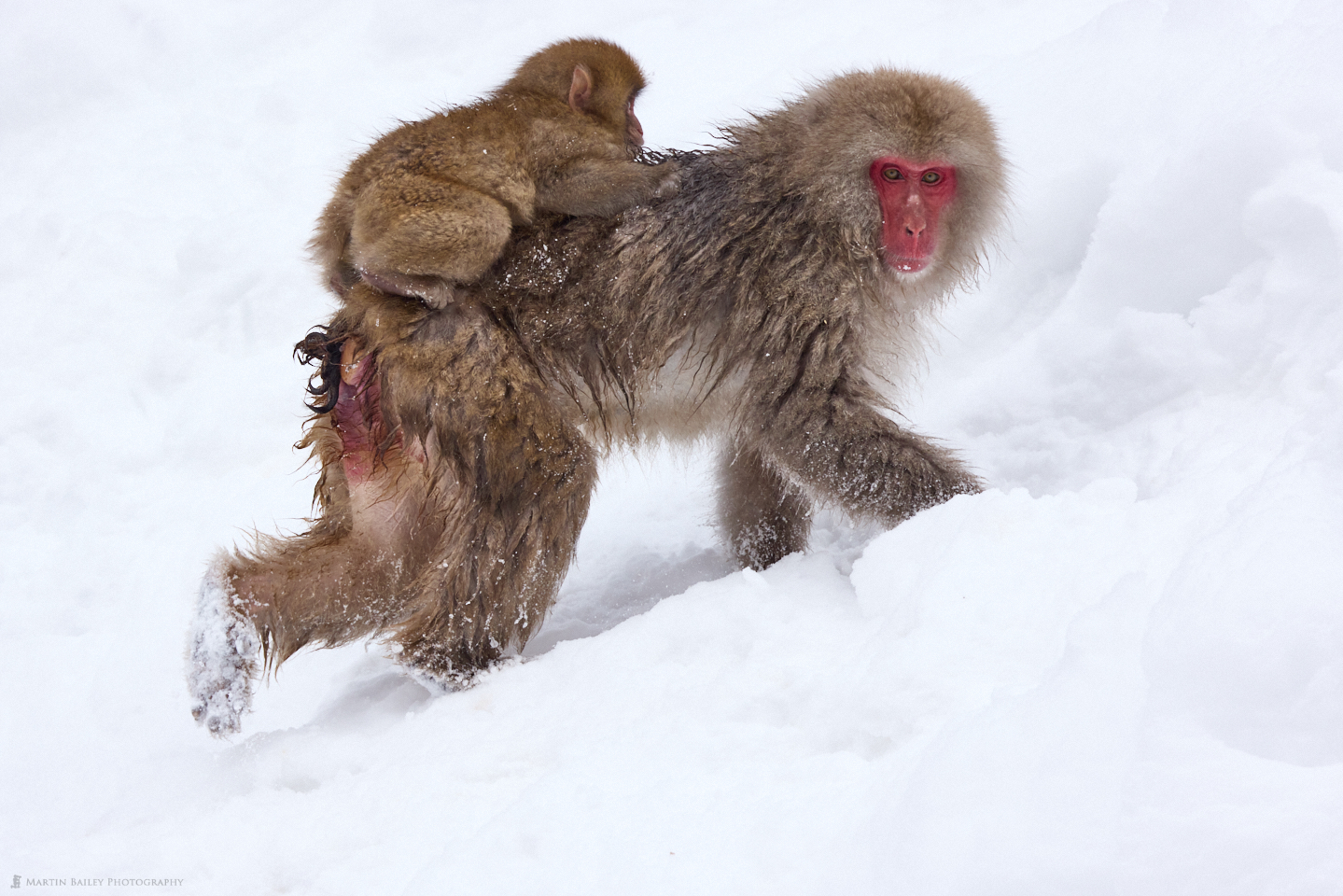
Sometimes, though, the tiny babies do find themselves having to walk through the cold snow, and I managed to tell a bit of a story around that in this next shot, of a baby from behind, with the soles of his cold little feet showing. I shot this at 500mm so I was already going to be a little bit wide, but I positioned the baby in the bottom left third so that the hill it had to climb was visible, depicting what we could conceive as the start of a journey.
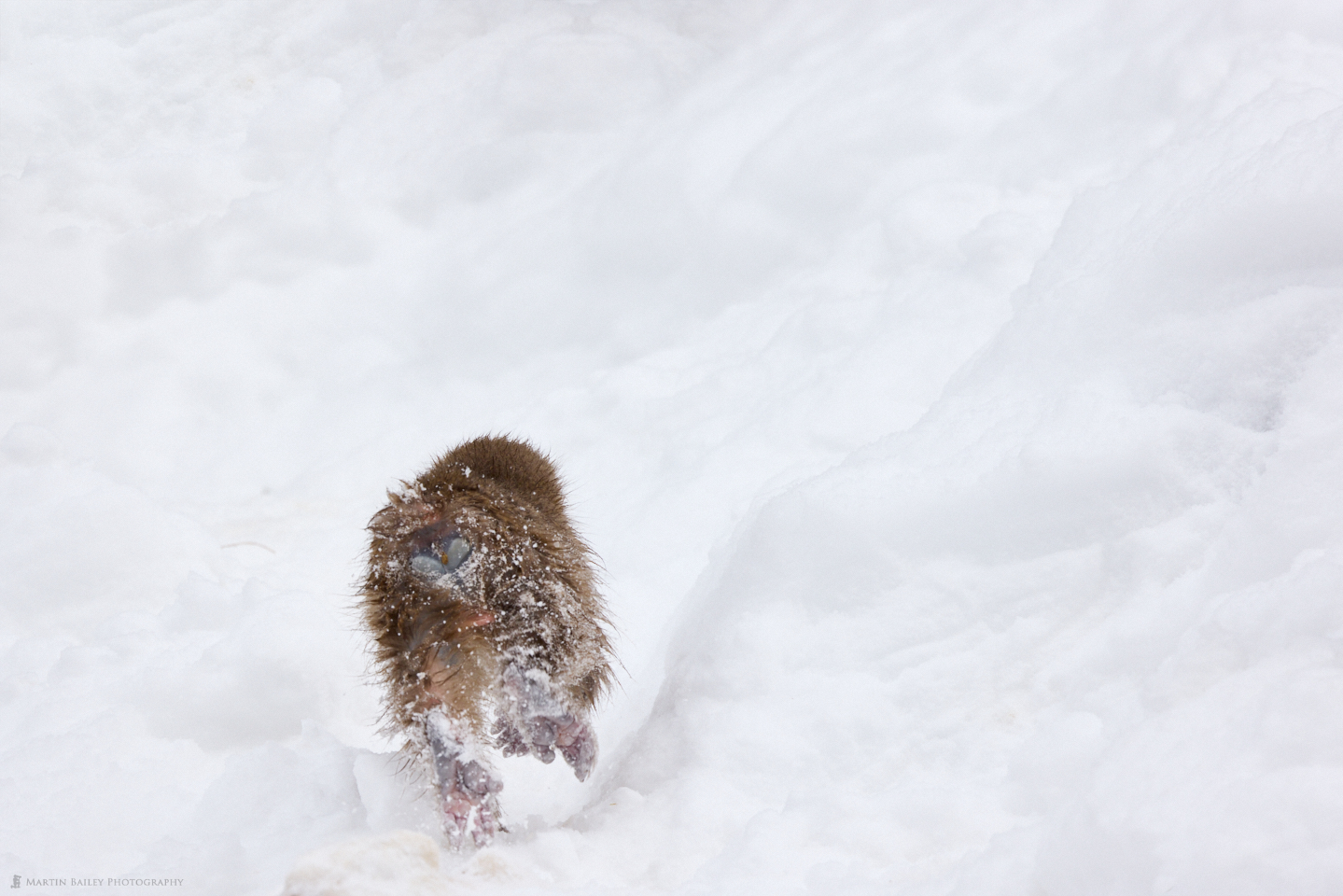
This was one of the last shots I took in the monkey park, as we set off shortly after this to get lunch, then drive back to Tokyo for one more night at the hotel before heading to Hokkaido the following morning.
A bright and early start got us into the field before 10 am, and things were different than they had been for many years, although this turned out to be another open door rather than a closed one. An avian flu outbreak in Hokkaido has them feeding the cranes only around half of the grain they usually provide them to have fewer cranes gather at once. As I’d expected, this didn’t work, as hungry birds will go where food is being thrown out and fight harder to be the ones that get what food there is. The birds were also being fed in a wider field next to the usual feeding area, and this led to some beautiful opportunities that had escaped me so far.
The main benefit, helped by it being slightly colder than usual, was that it gave us a better angle on the birds so that the sun was behind some of them, resulting in their breath being much more visible when they called. I used an extender, which made it impossible to capture the entire bird unless they were very far aware but enabled me to frame just their necks and heads so that the breath was highly visible, as you see in these next two images.
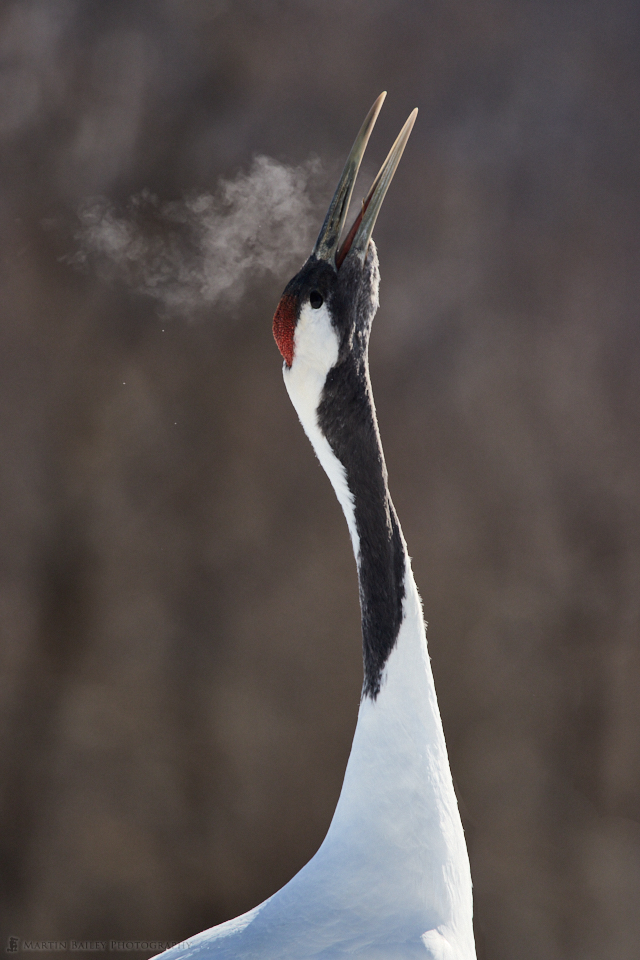
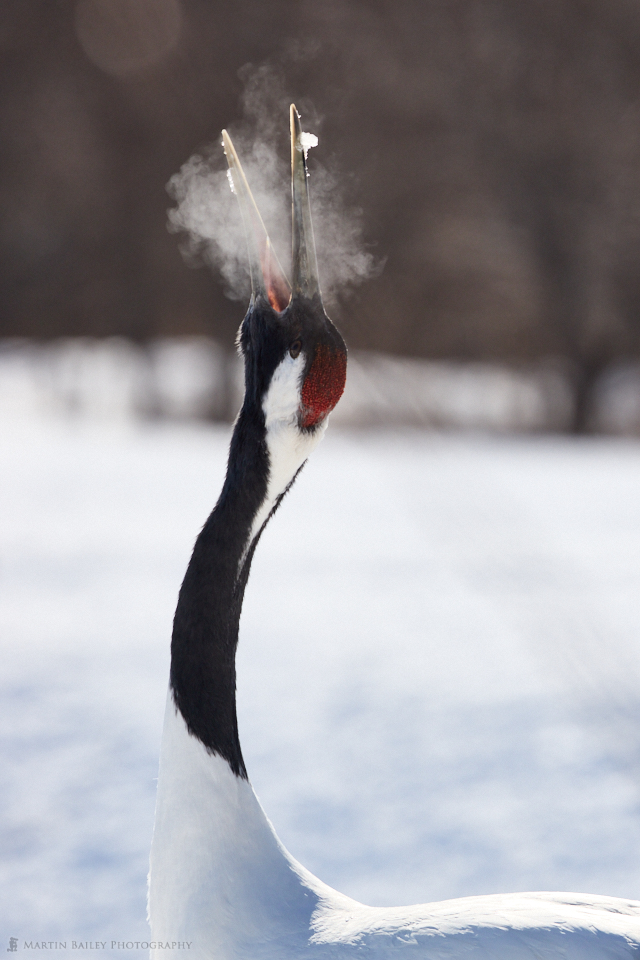
Unfortunately, because the light was behind the birds, we’re left without a catchlight to add life to their eyes, but I think the beautiful plumes of breath should hold the viewer’s attention long enough to not worry too much about that.
OK, so that’s our first ten images for part one of this series. As I mentioned, I will try to create part two before I leave in two days, for release next week. The 2024 Japan Winter Wildlife tours are filling fast, probably because the Japanese government is talking about removing the regulations requiring people to wear masks from March this year. That has been a sticking point for many overseas visitors. You can visit our Tours and Workshops page to check the vacancies and details of next year’s tours.
Show Notes
Visit our Tours and Workshops page for details of future tours: https://mbp.ac/tours
Subscribe in iTunes to get Podcasts delivered automatically to your computer.
Download this Podcast as an MP3 with Chapters.
Visit this page for help on how to view the images in MP3 files.


0 Comments